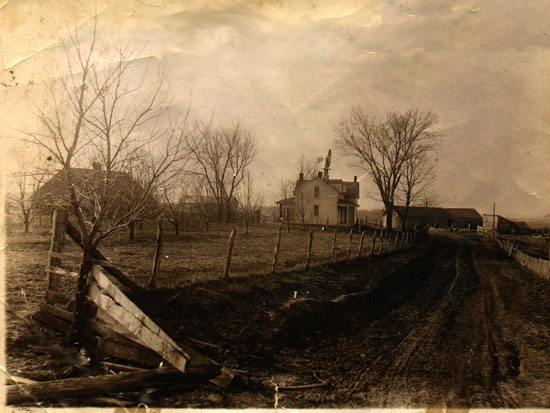

Commentary by David Boyle
The picture is from the end of the lane, and the most prominent feature is a broken-down gate in the foreground. (Mom was mortified, even though the picture was taken 40 years before she came to the farm.)
In those days, farms had a gate at the end of the lane, to keep the horses from wandering up the road. In this picture, the gate itself is no longer present. There is a makeshift fence of horizontal boards, from the corner of the orchard to the gatepost on the left side of the lane. The gatepost itself has fallen over, taking the boards along with it.
There are two sections of board fence, the first section being about 4 feet long, using a handy box elder tree as a post. The next section is sprawled fanlike, to where the gatepost used to be. The fence between the orchard and the lane is three strands of barbed wire.
The grass in the ditch between the fence and the laneway was recently burned. This and the absence of leaves on the tree lead to the conclusion that the picture was taken in early spring (maybe early March).
The fence on the west side of the lane was made of vertical boards (maybe to keep pigs in the field), somewhat dilapidated. There are wagon or buggy tracks on the lane, but no horse tracks (ground was packed).
The barn is visible on the left side of the picture. It is the barn that was torn down in 1953, single-pitch roof running north to south. I always thought that the old barn was rather plain; however, the barn in this picture has a cupola on top of it. Dad didn't recall a cupola - it must have blown off before his time.
The house also looks rather plain: no shutters or brickwork on the side. The west parlor porch is just like the east parlor porch: wooden columns, no brickwork. The elm tree is there, of course. Not much taller than two times the house. Windmill tower appears to be made of wood. There are no electric lines (the REA came through in the late '30s), but there do appear to be phone poles.
My guess is that an itinerant photographer took farm pictures in the area and later mailed the proof to each farm. The faint markings on the back of the print look like a photo proof stamp.